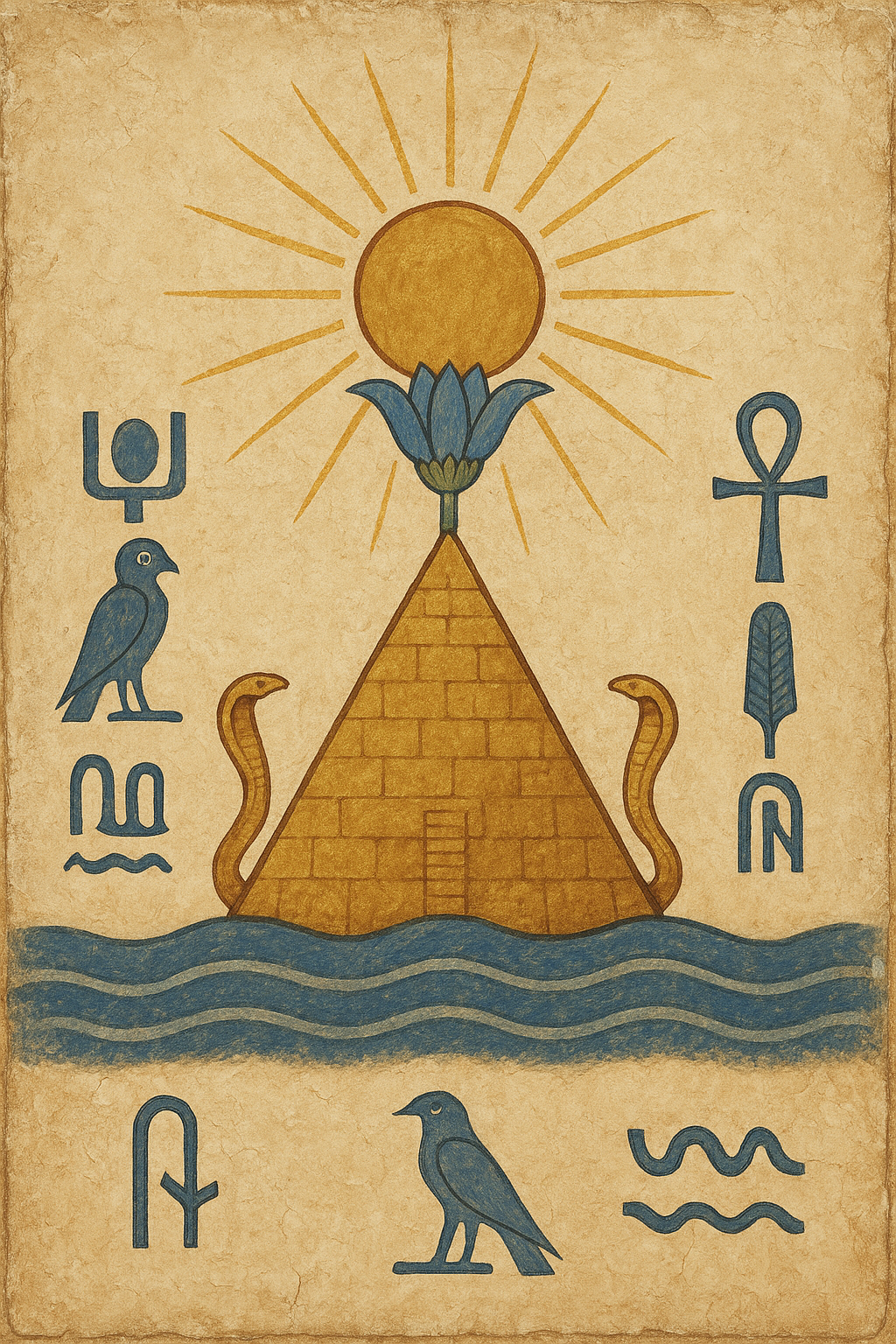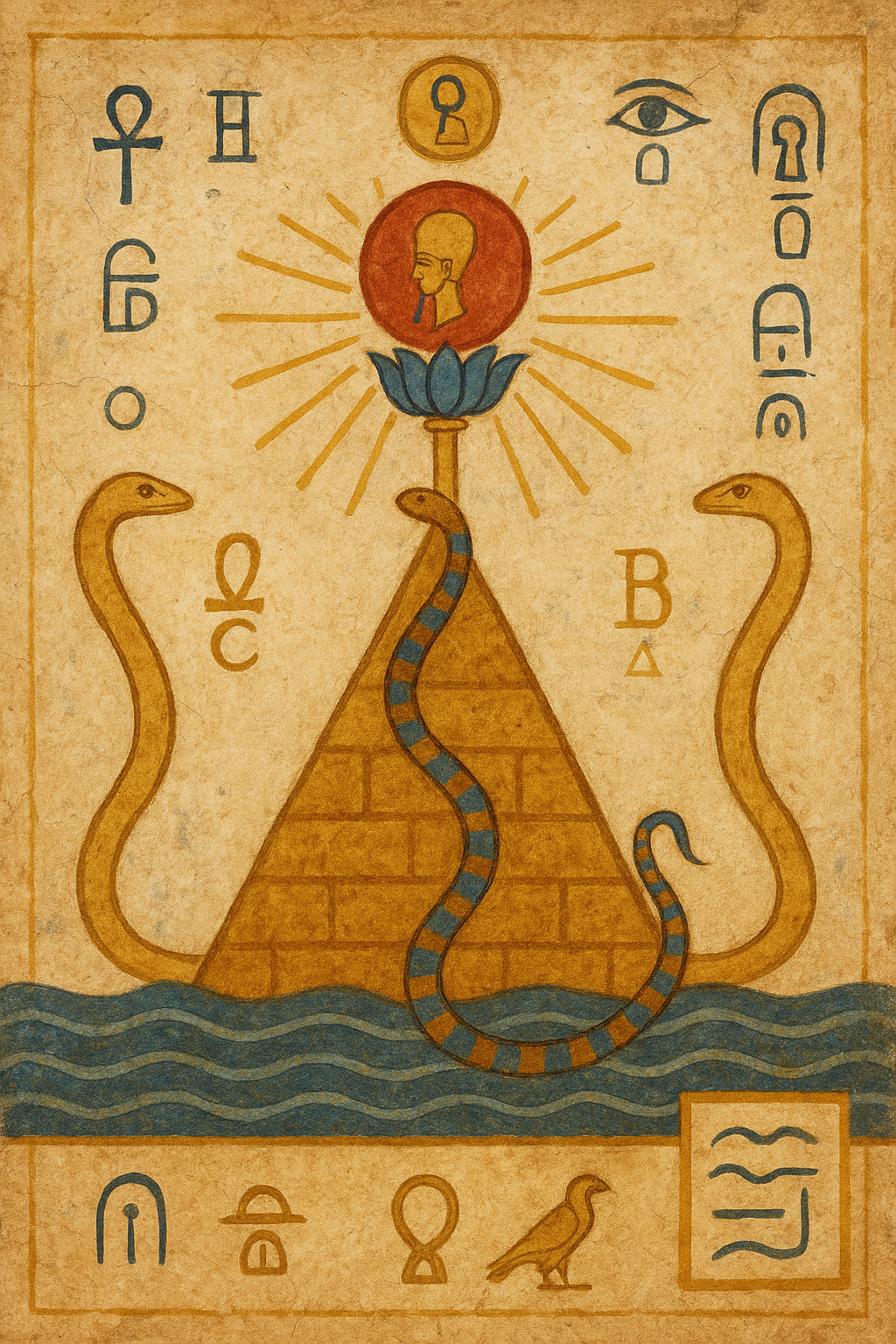The Primordial Mound in Ancient Egyptian Cosmology
Introduction
In the sacred cosmology of the ancient Egyptian Mystery Temples, the Primordial Mound (Benben) represents the first act of divine emergence, the point at which existence rises from the depths of non-being. This image of the mound arising from the infinite waters of Nun is not merely symbolic, it expresses a metaphysical truth rooted in Ma’at: that all creation is an act of divine order emerging from formlessness, a sacred unfolding of the eternal within time.
Nun and the Waters of Infinite Potential
In the theology of Heliopolis, Nun is not a god in the typical anthropomorphic sense, but a sacred field of infinite, pre-creative potential, the uncreated, unbounded waters that existed before all things. Nun is not “nothingness” in the nihilistic sense, but the undivided totality before manifestation, akin to a pre-cosmic ocean of pure latent being.
“He is the oldest of the gods, the father of the gods, the waters of the Nun, who existed in the beginning.”
— Coffin Texts, Spell 335
Nun is thus the cosmic womb from which all emerges and into which all may return, a timeless matrix beyond the cycles of Ra and the ordered world (Ma’at).
The Emergence of the Benben – The First Land
From the midst of this watery abyss, the Primordial Mound, Benben arose. According to the cosmogony of Heliopolis, it was upon this sacred mound that the creator god Atum first stood, self-generated, to begin the work of creation. The Benben is both literal and symbolic: it is the first solid place, the axis of order, and the prototype of the temple itself.
“I was alone in Nun, inert… I began to create out of my heart, and I ejaculated out of my mouth…”
— Pyramid Texts, Utterance 527
The Benben stone later became enshrined within the Temple of the Sun at Heliopolis, and was architecturally echoed in the pyramidal capstone and obelisk, the physical reflection of the first light rising from darkness.
Spiritual Symbolism of the Primordial Mound
Esoterically, the Benben is the point at which spirit (Ka) finds form, the moment of divine remembrance wherein the One begins to express itself as the Many. It is not merely the beginning of space and time, it is the beginning of orientation, direction, sacred architecture. Every temple, in some sense, is a replication of this mound, and the initiate’s inner journey mirrors this emergence: the rising of the soul (Ba) from the deep waters of forgetfulness into divine awakening.
The Benben also bears resonance with the concept of the “island of fire,” mentioned in various creation texts, where the Eye of Ra first rose and radiated divine light.
Comparisons to Genesis and the Influence on the Hebrew Tradition
It is often proposed by comparative theologians and Egyptologists that the Egyptian cosmogonic themes influenced later traditions, including that of the Hebrew Genesis. The account in Genesis 1:2 begins with the Spirit of God hovering over the “face of the waters,” a clear thematic resonance with Nun and the emergence of order from the abyss.
While direct proof of Mosaic authorship drawing explicitly from Egyptian texts is speculative, Moses was said to have been raised within the Egyptian royal household (cf. Exodus 2:10), and therefore would have had knowledge of Egyptian cosmological thought.
“And the earth was without form, and void; and darkness was upon the face of the deep…”
— Genesis 1:2
The parallels are undeniable in theme: darkness, water, formlessness, followed by the creative utterance “Let there be light” echoing Atum’s first act of creation through word and will.
Conclusion
The Primordial Mound is not simply a mythic concept, but a sacred key both in cosmic order and inner temple science. It teaches that even within the apparent chaos of formlessness, a seed of divine order is ever present, awaiting emergence. As initiates in the Mystery tradition of Kemet, we recognize the Benben not only in the beginning of worlds but in the sacred moment when the heart rises out of the waters of forgetfulness and remembers its divine source.
Primary Sources & Academic References
- The Pyramid Texts, trans. James P. Allen (2005)
- The Coffin Texts, trans. R. O. Faulkner (1973)
- Assmann, Jan. The Search for God in Ancient Egypt (Cornell University Press, 2001)
- Hornung, Erik. Conceptions of God in Ancient Egypt: The One and the Many (Cornell University Press, 1996)
- Wilkinson, Richard H. The Complete Gods and Goddesses of Ancient Egypt (Thames & Hudson, 2003)
- Allen, James P. Genesis in Egypt: The Philosophy of Ancient Egyptian Creation Accounts (Yale Egyptological Seminar, 1988)

